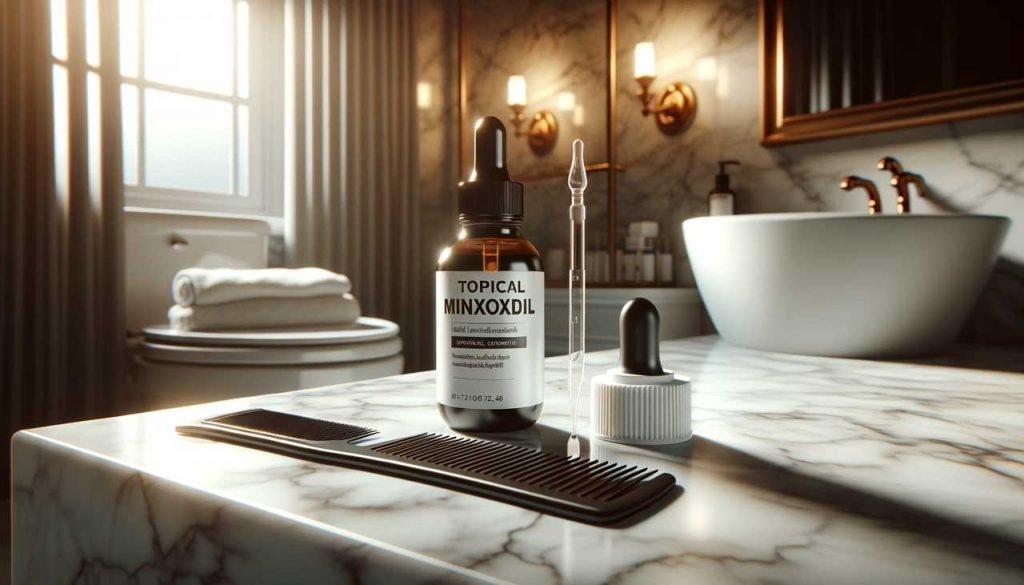Minoxidil for Hair Loss: The Ultimate Guide to Regrowth & Results
Through the Expert's Lens
Minoxidil is a potent vasodilator widely utilized within the therapeutic domain for its notable success in mitigating androgenetic alopecia, a common affliction shared among our communities. Originally conceived for hypertension management, its fortuitous application in hair regrowth has fostered an inclusive approach to addressing hair loss. As a member of our collective endeavor for improved well-being, you may find reassurance in Minoxidil's topical form, designed to fortify hair follicle vitality and augment hair volume. Its biochemical activity is presumed to extend the anagen phase, thus bolstering the hair's natural lifecycle. Before initiating treatment, a professional consultation is advised to ensure compatibility and to address any dermatological sensitivities preemptively. Adherence to prescribed usage is crucial to attaining and sustaining hair restoration benefits, while monitoring for adverse reactions remains a shared responsibility. Minoxidil's integration into daily regimens represents a commitment to communal health and personal confidence.
Frequently Asked Questions
Does Topical Minoxidil Regrow Hair?
Clinical evidence supports that this treatment can significantly enhance hair density and stimulate new growth in individuals experiencing hair loss.
15.9%: Percentage of men who found 5% minoxidil "very effective" in stimulating new hair growth after one year.
47.8%: Percentage of men who found 5% minoxidil "effective" in stimulating new hair growth after one year.
What Is the Major Side Effect of Topical Minoxidil?
The primary adverse effect of the discussed treatment is excessive hair growth in undesired areas, a condition known as hypertrichosis. This outcome necessitates consideration when evaluating the medication's suitability for individual use.
How does Minoxidil work for hair loss?
Minoxidil increases blood flow to the scalp and promotes hair follicle growth. It's not fully understood, but it may also stimulate hair growth by extending the growth phase (anagen).
What are the different types of Minoxidil available?
Minoxidil is available in topical solutions (2% and 5%) and foam (5%). The foam may be easier for some people to apply and less greasy.
How long does it take to see results?
It can take 3-6 months of consistent use to see noticeable results. Some people may see initial shedding in the first few weeks, which is normal.
Can I use Minoxidil if I'm pregnant or breastfeeding?
No, Minoxidil should not be used during pregnancy or breastfeeding.
Table of Contents

Minoxidil's Mechanism
Minoxidil's mechanism of action is multifaceted, primarily stimulating hair growth by shifting follicular cells into the anagen, or growth phase. It exerts vasodilatory effects, likely mediated through the opening of potassium channels, which improves blood flow to the hair follicles. Additionally, Minoxidil enhances cellular activity and proliferation, further contributing to its therapeutic efficacy in hair regrowth.
Hair Growth Stimulation
Through its complex action on hair follicles, Minoxidil stimulates hair growth by shifting secondary hair germ cells into the anagen phase, the active growth stage of hair. This transition is crucial for those affected by conditions such as male pattern baldness, where prolonging the anagen phase can significantly mitigate the progression of hair loss. Minoxidil's efficacy is reinforced by its ability to induce perifollicular vascularization, nourishing the scalp and reducing scalp irritation.
| Aspect of Hair Growth | Influence of Minoxidil |
|---|---|
| Anagen Phase Prolongation | Stimulates longer growth periods |
| β-catenin Activity | Enhances follicular proliferation |
| Perifollicular Vascularization | Increases nutrient flow to follicles |
The technical nuances of Minoxidil's mechanism offer hope for individuals seeking to reclaim a sense of belonging through enhanced hair growth.
Vasodilation Effects
The vasodilatory mechanism of Minoxidil is integral to its efficacy in promoting hair regrowth by enhancing blood flow to the follicles. Initially employed as a medication to treat high blood pressure, Minoxidil's potent vasodilation effects were repurposed to address hair loss. It operates by widening blood vessels, thereby reducing vascular resistance and improving perifollicular blood flow. This action facilitates the delivery of oxygen and nutrients essential for hair follicle health and function. Moreover, Minoxidil modulates molecular pathways, including upregulating VEGF mRNA expression and activating hypoxia-inducible factor-1-alpha. These pathways contribute to increased fenestration in the follicular capillary wall, promoting an enriched blood supply conducive to revitalizing secondary hair germ cells and the rapid progression of the hair cycle's anagen phase.
Cellular Activity Increase
While the vasodilatory effects of Minoxidil enhance blood supply to hair follicles, its ability to increase cellular activity is pivotal in stimulating hair regrowth at a molecular level. The precise mechanisms by which minoxidil topical treatment encourages hair to regrow involve complex biochemical processes that include:
- Prolongation of the Anagen Phase
- Induction of β-catenin activity
- Stimulation of follicular proliferation
- Enhancement of Cellular Environment
- Increase in VEGF mRNA expression
- Regulation of perifollicular vascularization
Individuals who use this medication can expect increased cellular activity, clinically manifesting improved hair density and vitality. As a community of users who seek to overcome hair loss, embracing minoxidil treatment represents a shared journey toward regaining not just hair but also a sense of belonging and confidence.
Application Guidelines for Minoxidil
The application of Minoxidil requires adherence to specific guidelines to ensure both efficacy and safety. It is imperative to apply the medication in the correct dosage and with precise timing, as recommended by healthcare professionals or the product instructions. Proper scalp application involves a clean and dry surface, with the solution or foam spread evenly over the areas of thinning hair.
Correct Dosage Timing
Adherence to the recommended dosage schedule is crucial for the efficacy of Minoxidil in treating hair loss. The medication must be used consistently to maintain hair regrowth and prevent further shedding.
- For optimal results:
- Apply the minoxidil solution to a dry scalp as directed.
- If you miss a dose, do not double the next dose; resume the regular application schedule.
Using this product requires patience and commitment. The technical guidelines highlight the importance of timing:
- Timing considerations:
- Use the product at evenly spaced intervals.
- Consistency in application reinforces the sense of belonging to a community committed to managing hair loss.
Minoxidil is a long-term treatment, and its success depends on following these precise application guidelines.
Proper Scalp Application
As per the manufacturer's instructions, consistently applying Minoxidil directly to a dry scalp is essential for the treatment's effectiveness in combating hair loss. Adherence to this protocol fosters a sense of shared commitment among those pursuing hair regrowth goals. As a medical guideline, avoiding wet conditions during scalp application is crucial to ensure optimal absorption and efficacy. Users should eschew the urge to shampoo immediately before use unless specified by a healthcare provider or clinic protocol. Over-application or deviation from recommended frequency can precipitate undesirable side effects and compromise patient safety. It is incumbent upon users to follow these directives meticulously, as they result from rigorous clinical scrutiny designed to maximize treatment outcomes within the hair regrowth community.
Recognizing Potential Side Effects
During treatment with Minoxidil, patients should be vigilant for side effects such as burning, stinging, or redness at the application site. It's crucial to:
- Report Side Effects
- *To Healthcare Providers*: Keep them informed of any adverse effects.
- *To Regulatory Agencies*: Ensuring the safety of the medication for all users.
- Seek Medical Attention
- *Allergic Reaction to Minoxidil*: Symptoms like rash or difficulty breathing necessitate immediate action.
- *Severe Adverse Effects*: Call your doctor if you have chest pain or unwanted facial/body hair.
Engaging with a community that understands and shares the challenges of hair loss can provide support and advice when confronting these potential side effects. Always remain proactive in managing your health and well-being while using Minoxidil.
Minoxidil's Effectiveness in Treatment
The therapeutic efficacy of Minoxidil in treating hair loss conditions is well-established, yet individual responses to the treatment can exhibit considerable variability. Long-term application of Minoxidil is essential for sustaining hair regrowth, with discontinuation often leading to the reversal of benefits. Research indicates that consistent use over a protracted period is critical for evaluating the full impact of Minoxidil on hair loss stabilization and density enhancement.
Success Rate Variability
Clinical studies have pointed out that the effectiveness of Minoxidil in treating hair loss varies with different concentrations, with a 5% solution generally leading to a more significant increase in hair density than a 2% solution. The variability in success rates is crucial health information for individuals seeking treatment, as the choice of concentration can impact the outcome.
- Factors influencing success rates:
- IndividuResponsense to Minoxidil
- Duration of treatment adherence
- Importance of professional guidance:
- Minimizing potential side effects
- Tailoring treatment to specific conditions
Before starting treatment, consulting a doctor for medical advice is essential to ensure Minoxidil is appropriate for your condition. Mayo Clinic patient testimonials often highlight the importance of following clinic pressMayo Clinic Health guidelines to maximize treatment efficacy while minimizing risks.
Long-term Usage Impact
Long-term administration of Minoxidil is essential for maintaining its therapeutic benefits in hair regrowth and minimizing subsequent hair loss. Continuous use upholds the medication's ability to prolong the anagen phase, thus fostering a conducive environment for sustained follicular activity. Adhering to the prescribed regimen is crucial; deviation may lead to reversing benefits and acceleration of hair loss. Individuals seeking medical advice about side effects and optimal health outcomes may consult resources such as Mayo Clinic health information. While side effects are possible, they are typically manageable and should be weighed against the benefits of prolonged treatment. Users must remain informed about potential side effects to make educated decisions in concert with healthcare professionals.
Safety Measures and Interactions
Regarding safety measures and interactions, minoxidil users should be aware that this medication may adversely interact with certain other drugs and health conditions. It is crucial to exercise caution to prevent any potential side effects.
- Safety Measures:
- Always avoid getting the medication in your eyes, and if accidental contact occurs, rinse thoroughly with water.
- Stop using the product and contact a healthcare provider if you experience severe side effects or allergic reactions.
- Interactions:
- Be mindful of the product's inactive ingredients, which may cause allergic reactions in sensitive individuals.
- In cases of overdose or serious side effects, promptly reach out to a poison control center for guidance.
Joining a community of minoxidil users can provide support and share experiences regarding these safety measures and interactions.
References:
Minoxidil: A Comprehensive Review
Minoxidil and its use in hair disorders: a review
